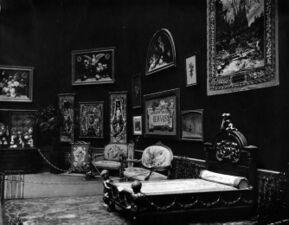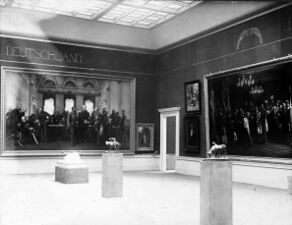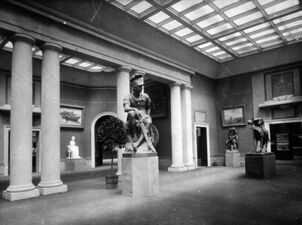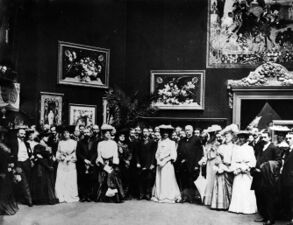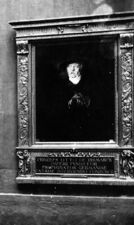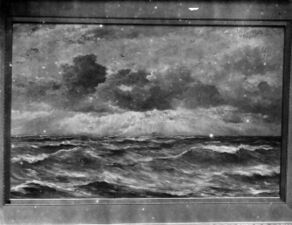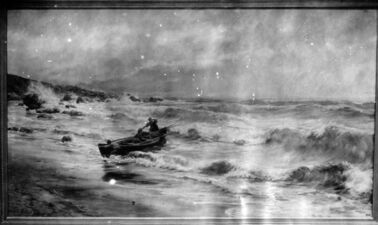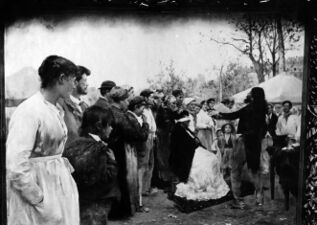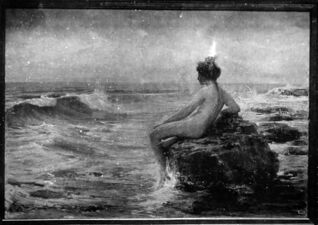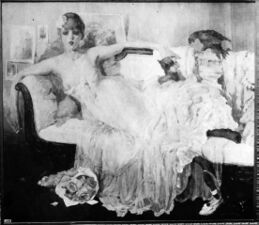Palace of Fine Arts: Difference between revisions
No edit summary |
No edit summary |
||
| (18 intermediate revisions by the same user not shown) | |||
| Line 1: | Line 1: | ||
{{ | {{SHORTDESC:Palace of Fine Arts}} | ||
{{Infobox FairBuilding | |||
| name = Palace of Fine Arts | |||
| image = Palace of Fine Arts.jpg | |||
| image_alt = | |||
| image_size = 400px | |||
| caption = Palace of Fine Arts | |||
| alternate_name = | |||
| location = [[Art Hill]] | |||
| no_buildings = 4 | |||
| construction_cost= | |||
| furnishing_cost = | |||
| profit = | |||
| owner = | |||
| architect = Cass Gilbert, of New York | |||
| dimensions = | |||
| adult_entry = | |||
| child_entry = | |||
| opening_day = | |||
| dedication_day = | |||
| special_day = | |||
| other = | |||
| floorplan_image = FP-Palace of Fine Arts.jpg | |||
| ticket_image = | |||
}} | |||
The Palace of Fine Arts was the only permanent building built on the Exposition grounds. Located 60 feet above the general level on Art Hill, the imposing edifice stood directly south of | The '''Palace of Fine Arts''' was the only permanent building built on the Exposition grounds. Located 60 feet above the general level on [[Art Hill]], the imposing edifice stood directly south of [[Festival Hall]]. | ||
==Before the Fair== | ==Before the Fair== | ||
| Line 8: | Line 32: | ||
==Architecture== | ==Architecture== | ||
In composition, the Palace is a tall nave, fronted by a Corinthian portico, above which gives abundant light for the interior. On each side of the main entrance are seated figures, one representing Sculpture, executed by Daniel Chester French, and the other representing Painting and executed by Louis Saint Gaudens. | In composition, the Palace is a tall nave, fronted by a Corinthian portico, above which gives abundant light for the interior. On each side of the main entrance are seated figures, one representing Sculpture, executed by Daniel Chester French, and the other representing Painting and executed by Louis Saint Gaudens. | ||
Above the main portico are six figures symbolizing the six great periods of art, as follows: Egyptian Art, by Albert Yaegers; Classic Art, by F. E. Elwell; Gothic Art, by John Gelert; Oriental Art, by Henry Linder; Renaissance Art, by Carl Tefft; Modern Art, by C. F. Hanann. The figure, | Above the main portico are six figures symbolizing the six great periods of art, as follows: ''Egyptian Art'', by Albert Yaegers; ''Classic Art'', by F. E. Elwell; ''Gothic Art'', by John Gelert; ''Oriental Art'', by Henry Linder; ''Renaissance Art'', by Carl Tefft; ''Modern Art'', by C. F. Hanann. The figure, ''Inspiration'', crowning the building, above the main entrance, was executed by Andrew O'Connor. Two bronze griffins, which are effectively used as ornamentations on either end of the main pediment at its base, were executed by A. Phimister Proctor. | ||
Near each end of the front of the Central Building, in niches, were two seated figures, representing | Near each end of the front of the Central Building, in niches, were two seated figures, representing ''Truth'', by Chas. Grafly, and ''Nature'', by Philip Martiny. The last five named figures are gilded, a golden note which is repeated at intervals on all the structures and decorations of Art Hill. | ||
[[File:Palace of Fine Arts Medallions.jpg|200px|thumb|''Medallion'' by George T. Brewster]] | |||
In the frieze of the main building were placed twenty medallions in stone, containing portraits of the great architects, painters and sculptors, executed by George T. Brewster and O. Piccirilli. The intermediate figures surrounding the base of the building were replicas from the antique. The East and the West Pavilions, giving, with the Central Building, a total length on the front of eight hundred and thirty feet, and extending back four hundred and fifty feet, enclose a Quadrangle in which is located the fourth building of the group, the International Sculpture Court, which was built, like the East and West Pavilions, of brick ornamented with staff. This court is one hundred and fifty feet long by one hundred feet wide, its plan being rectangular with an exedra or semi-circular bay at the east and west ends. In architecture it was lighter and more decorative than the main buildings, with motives from the Italian Renaissance. The enclosed space was laid out as a garden, where fountains, growing plants and shrubbery were introduced. Here is suggested, beside the close relation between the allied arts of sculpture and architecture, the relation of art to nature. | In the frieze of the main building were placed twenty medallions in stone, containing portraits of the great architects, painters and sculptors, executed by George T. Brewster and O. Piccirilli. The intermediate figures surrounding the base of the building were replicas from the antique. The East and the West Pavilions, giving, with the Central Building, a total length on the front of eight hundred and thirty feet, and extending back four hundred and fifty feet, enclose a Quadrangle in which is located the fourth building of the group, the International Sculpture Court, which was built, like the East and West Pavilions, of brick ornamented with staff. This court is one hundred and fifty feet long by one hundred feet wide, its plan being rectangular with an exedra or semi-circular bay at the east and west ends. In architecture it was lighter and more decorative than the main buildings, with motives from the Italian Renaissance. The enclosed space was laid out as a garden, where fountains, growing plants and shrubbery were introduced. Here is suggested, beside the close relation between the allied arts of sculpture and architecture, the relation of art to nature. | ||
| Line 51: | Line 76: | ||
==Domestic Collections== | ==Domestic Collections== | ||
[[File:Psyche Seeks Love.jpg|200px|thumb|''Psyche Seeks Love'' by ERobert Van Vorst Sewell]] | |||
The foreign collections of paintings were arranged so that the visitor could study them in relation to the national art of and character of the American people, including the results of European influence and culture. Though American artwork had always held a back seat to European, the collection of works from the Fair's home country was deemed very high indeed. | The foreign collections of paintings were arranged so that the visitor could study them in relation to the national art of and character of the American people, including the results of European influence and culture. Though American artwork had always held a back seat to European, the collection of works from the Fair's home country was deemed very high indeed. | ||
| Line 58: | Line 84: | ||
The famous Tiffany & Company was on display at the Fair. The works of Louis Comfort Tiffany included a sterling silver Renaissance-inspired vegetable dish, a dragonfly brooch, a brooch of leaves and berries, and an ivory tusk inkstand which bears the "fleur-de-lis" mark, significance to the Art Nouveau movement. | The famous Tiffany & Company was on display at the Fair. The works of Louis Comfort Tiffany included a sterling silver Renaissance-inspired vegetable dish, a dragonfly brooch, a brooch of leaves and berries, and an ivory tusk inkstand which bears the "fleur-de-lis" mark, significance to the Art Nouveau movement. | ||
[[File:Rosa_Corder_by_James_McNeill_Whistler.jpg|200px|thumb|''Portrait of Rosa Corde'' by James McNeill Whistler]] | |||
St. Louis' artist were also proudly showcased, Noted St. Louis painter- Edmund Wuerpel displayed four paintings, and Frederick O. Sylvester exhibited his known oil ''The Bridge''. A small bust of a baby, by Bessie Potter Vonnoh, was the only female artist from St. Louis to exhibit in the Palace of Fine Arts. | |||
One of the highlight's was Whistler's ''Rosa Corder''. | |||
One of the highlight's was Whistler's | |||
==Foreign Collections== | ==Foreign Collections== | ||
| Line 67: | Line 93: | ||
===Europe=== | ===Europe=== | ||
====Austria==== | ====Austria==== | ||
Art in Austria was organized in four great national societies. Besides the exhibits of the two Austrian societies, including such artists as Hugo Charlemont, Alois Schram and Karl Pippich, there | Art in Austria was organized in four great national societies. Besides the exhibits of the two Austrian societies, including such artists as Hugo Charlemont, Alois Schram and Karl Pippich, there were those of the Bohemian and Polish artists, each displayed distinctive national traits. Owing to the lack of space which it was possible to assign to Austria, only a portion of these collections was placed in the Art Palace, the remainder being installed in their [[Austria|National Pavilion]]. | ||
====Belgium==== | ====Belgium==== | ||
[[File:The Intruders by Eugène Laermans.jpg|200px|thumb|''The Intruders'' by Eugène Laermans]] | |||
[[File:Venus by Henri Thomas.jpg|200px|thumb|''Venus'' by Henri Thomas.jpg]] | |||
The exhibit in the Belgian Section represented the art activity of the last decade, all the paintings having been produced during that time. In the sculpture, which is installed both in the Art Palace, and the galleries of the Sculpture Pavilion. Frans Courtens, Leempoels, Heymans, Verhaert, and Gilsoul are among the noted names in Belgian art, and were represented here by important works in figure and landscape. | The exhibit in the Belgian Section represented the art activity of the last decade, all the paintings having been produced during that time. In the sculpture, which is installed both in the Art Palace, and the galleries of the Sculpture Pavilion. Frans Courtens, Leempoels, Heymans, Verhaert, and Gilsoul are among the noted names in Belgian art, and were represented here by important works in figure and landscape. | ||
| Line 75: | Line 103: | ||
====France==== | ====France==== | ||
[[File:Death and the Woodcutter.jpg|200px|thumb|''Death and the Woodcutter'' by Leon Lhermitte]] | |||
The French nation was the largest and most important one that was ever sent out of its own country. Among works in the French Section representing the older masters of that school were those of Carolus Duran, Bouguereau, Henner, Detaille, Flameng, Puvis de Chavannes, Robert Fleury, and L'hermitte. | The French nation was the largest and most important one that was ever sent out of its own country. Among works in the French Section representing the older masters of that school were those of Carolus Duran, Bouguereau, Henner, Detaille, Flameng, Puvis de Chavannes, Robert Fleury, and L'hermitte. | ||
Another highlight was the first of the 21 casts authorized by Rodin of one of the most known sculptures in the world- | Another highlight was the first of the 21 casts authorized by Rodin of one of the most known sculptures in the world-''The Thinker''. The Metropolitan Museum of Art in New York, also loaned a plaster cast of François-Auguste-René Rodin's masterpiece for the Fair. | ||
====Germany==== | ====Germany==== | ||
| Line 84: | Line 113: | ||
The exhibition of the British Section was representative of the art work of Great Britain, Scotland and Ireland during the last decade. The Art Committee, made up of the presidents of the various art societies of the United Kingdom, gives assurance that the exhibition is national in its scope, including the three great painters, Millais, Leighton and Burne-Jones, who have died during the last decade—with others of world-wide reputation, are represented here. | The exhibition of the British Section was representative of the art work of Great Britain, Scotland and Ireland during the last decade. The Art Committee, made up of the presidents of the various art societies of the United Kingdom, gives assurance that the exhibition is national in its scope, including the three great painters, Millais, Leighton and Burne-Jones, who have died during the last decade—with others of world-wide reputation, are represented here. | ||
In sculpture, an exhibit that showed the influence of such artists as William Morris and Walter Crane—the largest exhibition of its kind which England has made at any exposition. | In sculpture, an exhibit that showed the influence of such artists as William Morris and Walter Crane—the largest exhibition of its kind which England has made at any exposition. | ||
The British exhibit, occupied fourteen rooms, showcased a theme familiar with the Fair's outlook, hence they had a sizeable exhibit of Pre-Raphelite and Neo-Classical painters oils as: Sir J. E. Millais' | The British exhibit, occupied fourteen rooms, showcased a theme familiar with the Fair's outlook, hence they had a sizeable exhibit of Pre-Raphelite and Neo-Classical painters oils as: Sir J. E. Millais' ''Chill October'',Lord Federick Leighton's ''Persus and Pegasus with the Head of Medusa'', and Sir Edward Burne-Jones' ''The Dream of Lancelot at the Chapel of the San Grael'',were extremely well-received. | ||
====Holland==== | ====Holland==== | ||
| Line 99: | Line 128: | ||
The exhibit of Portugal was shown in one gallery, painting and sculpture being grouped together. Among the more prominent artists of Portugal were Salgado and Columbano, represented here mainly by portraits, and Jose de Brito. | The exhibit of Portugal was shown in one gallery, painting and sculpture being grouped together. Among the more prominent artists of Portugal were Salgado and Columbano, represented here mainly by portraits, and Jose de Brito. | ||
===Sweden=== | ====Sweden==== | ||
The impression made by the Swedish pictures showcased the patriotism of Sweden. Among the artists in the exhibition best known in this country were Zorn, Liljefors, and Carl Larsson. | The impression made by the Swedish pictures showcased the patriotism of Sweden. Among the artists in the exhibition best known in this country were Zorn, Liljefors, and Carl Larsson. | ||
| Line 107: | Line 136: | ||
====Russia==== | ====Russia==== | ||
Russia was represented by a collection of over six hundred works of art, consisting mainly of paintings. Ten different art societies were represented, and included paintings of such well-known members of the Imperial Academy of Arts as: Repin, Vladimir and Alexander Makofsky, Dubofsky, Kasatkine, Volkoff, Soukherofsky, Kosheleff, Venig, Verestchagin, Maimon, and von Liebhardt. In addition, there was independent collections illustrative of | Russia was represented by a collection of over six hundred works of art, consisting mainly of paintings. Ten different art societies were represented, and included paintings of such well-known members of the Imperial Academy of Arts as: Repin, Vladimir and Alexander Makofsky, Dubofsky, Kasatkine, Volkoff, Soukherofsky, Kosheleff, Venig, Verestchagin, Maimon, and von Liebhardt. In addition, there was independent collections illustrative of ''Ancient Russia'', ''The Ural and its Riches'' and ''Siberia'', which at that time had never before been displayed outside of Russia. | ||
===America=== | ===America=== | ||
====Argentina==== | ====Argentina==== | ||
[[File:No Bread and No Work.jpg|200px|thumb|''Without Bread and Without Work'' by Ernesto De La Carcova]] | |||
The works of art exhibited in the Argentine Section were by painters and sculptors who have studied in France and Italy. They impressed fairgoers one with its individuality, sense of harmony and purity of style. Among the artists whose works were represented: Eduardo Sivori, Ernesto' de la Carcova, Eduardo Schiaffino, Pio Collivadino, Carlos Ripamonte, Cesarep de Quiros, Correa Morales, Irurtia, Dresco, Alonso, Artigue, Giudici, Garcia and Diana Dampt. | The works of art exhibited in the Argentine Section were by painters and sculptors who have studied in France and Italy. They impressed fairgoers one with its individuality, sense of harmony and purity of style. Among the artists whose works were represented: Eduardo Sivori, Ernesto' de la Carcova, Eduardo Schiaffino, Pio Collivadino, Carlos Ripamonte, Cesarep de Quiros, Correa Morales, Irurtia, Dresco, Alonso, Artigue, Giudici, Garcia and Diana Dampt. | ||
| Line 117: | Line 147: | ||
====Canada==== | ====Canada==== | ||
Art in Canada was of comparatively recent growth, and the present exhibition is under the direction of the Royal Canadian Academy. The works in the Canadian galleries were entirely pictorial, and were the work of Canadian artists who studied in the art centers of Europe, and returned home to paint | Art in Canada was of comparatively recent growth, and the present exhibition is under the direction of the Royal Canadian Academy. The works in the Canadian galleries were entirely pictorial, and were the work of Canadian artists who studied in the art centers of Europe, and returned home to paint. | ||
====Cuba==== | ====Cuba==== | ||
| Line 124: | Line 154: | ||
====Mexico==== | ====Mexico==== | ||
Mexico had an exhibit of paintings which in figure and landscape gives glimpses of the life of the country, the most notable feature of the exhibit being the collection of paintings by Antonio Fabres. | Mexico had an exhibit of paintings which in figure and landscape gives glimpses of the life of the country, the most notable feature of the exhibit being the collection of paintings by Antonio Fabres. | ||
===Other=== | ===Other=== | ||
The International Section were made up from the works of artists of countries not officially represented by national commissions or committees. Among them were works by Norwegian, Danish, Peruvian and Swiss artists, and an exhibit from Ceylon and China of paintings and works of applied art. | The International Section were made up from the works of artists of countries not officially represented by national commissions or committees. Among them were works by Norwegian, Danish, Peruvian and Swiss artists, and an exhibit from Ceylon and China of paintings and works of applied art. | ||
==After the Fair== | ==After the Fair== | ||
The main building of the Palace of Fine Arts is now the St. Louis Art Museum. | The main building of the Palace of Fine Arts is now the St. Louis Art Museum. | ||
Fair President David R. Francis stated "St. Louis did more (than Chicago); it set a standard of American performance in art that, while it was a surprise to foreign connoisseurs, will mark an epoch of progress of the world." | Fair President David R. Francis stated "St. Louis did more (than Chicago); it set a standard of American performance in art that, while it was a surprise to foreign connoisseurs, will mark an epoch of progress of the world." | ||
==Gallery== | |||
<gallery | class="center" | mode=packed-hover | widths=150px heights=150px>> | |||
File:Palace of Fine Arts - Side.jpg | Front View | |||
File:Arts - France.jpg | French Exhibit | |||
File:Arts - Germany 2.jpg | German Exhibit | |||
File:Arts - Germany.jpg | German Exhibit | |||
File:Arts - Interior.jpg | Interior | |||
File:Arts - Interior 2.jpg | Interior | |||
File:Arts - Interior 3.jpg | Interior | |||
File:Arts - Interior 4.jpg | Interior | |||
File:Arts - Painting.jpg | Painting | |||
File:Arts - Painting 2.jpg | Painting | |||
File:Arts - Painting 3.jpg | Painting | |||
File:Arts - Painting 4.jpg | Painting | |||
File:Arts - A Pearl.jpg | A Pearl | |||
File:Arts - Argentine - Hour of Rest by Collivandin.jpg |Hour of Rest by Collivandin | |||
File:Arts - Argentine - Ernesto De La Carcova - Without Bread and Without Work.jpg | Without Bread and Without Work by Ernesto De La Carcova | |||
File:Arts - Belgium - The Intruders by Eugène Laermans.jpg | The Intruders by Eugène Laermans | |||
File:Arts - Belgium.jpg | Venus by Henri Thomas | |||
File:Arts - Death of the Woodcutter Léon Lhermitte.jpg | Death of the Woodcutter Léon Lhermitte | |||
File:Arts - Holland - The Best in the Market. Bisschop, Richard.jpg | The Best in the Market by Richard j Bisschop | |||
File:Arts - Holland - The Old Scribe by Jozef Israels.jpg | The Old Scribe by Jozef Israels | |||
File:Arts - In the Harbor of Naples Gaetano Esposito.jpg | In the Harbor of Naples Gaetano Esposito | |||
File:Arts - Italy - Gli effimeri Andrea Tavernier.jpg | Gli effimeri by Andrea Tavernier | |||
File:Arts - October by Bastert.jpg | October by Bastert | |||
File:Arts - Women Repairing Nets by Edgar Farazin.jpg | Women Repairing Nets by Edgar Farazin | |||
</gallery> | |||
==See also== | ==See also== | ||
| Line 147: | Line 197: | ||
==External links== | ==External links== | ||
[https://www.slam.org/ St. Louis Art Museum] | |||
[[Category:Main Picture]] | [[Category:Main Picture]] | ||
Latest revision as of 18:39, 10 December 2022
 | |
| Location | Art Hill |
|---|---|
| No. of Buildings | 4 |
| Architecture | |
| Architect | Cass Gilbert, of New York |
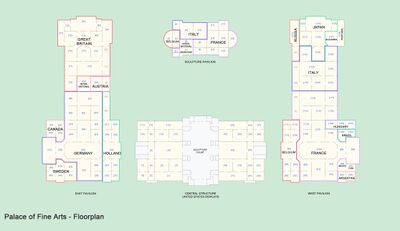 | |
The Palace of Fine Arts was the only permanent building built on the Exposition grounds. Located 60 feet above the general level on Art Hill, the imposing edifice stood directly south of Festival Hall.
Before the Fair[edit | edit source]
Designed by Cass Gilbert a famous New York architect who designed the United States Supreme Court building, as with the Palace of Fine Arts, he often used the Beaux Arts style to reflect the optimistic American sense that the nation was the heir of Greek democracy, Roman law and Renaissance humanism. For the Palace, Gilbert was heavily inspired by the Baths of Caracalla in Rome, Italy. The fire-proof palace consisted of two temporary wings of brick decorated in ornate staff. The main structure was constructed out of Bedford (or Salem),stone, the highest quality limestone in the United States. Like all limestone, it is a rock primarily formed of calcium carbonate. The stone helped to fire-proof the buildings art treasures as well as increase security from theft. In the open area at the rear of the main building and between the wings was the sculpture pavilion.
Architecture[edit | edit source]
In composition, the Palace is a tall nave, fronted by a Corinthian portico, above which gives abundant light for the interior. On each side of the main entrance are seated figures, one representing Sculpture, executed by Daniel Chester French, and the other representing Painting and executed by Louis Saint Gaudens. Above the main portico are six figures symbolizing the six great periods of art, as follows: Egyptian Art, by Albert Yaegers; Classic Art, by F. E. Elwell; Gothic Art, by John Gelert; Oriental Art, by Henry Linder; Renaissance Art, by Carl Tefft; Modern Art, by C. F. Hanann. The figure, Inspiration, crowning the building, above the main entrance, was executed by Andrew O'Connor. Two bronze griffins, which are effectively used as ornamentations on either end of the main pediment at its base, were executed by A. Phimister Proctor. Near each end of the front of the Central Building, in niches, were two seated figures, representing Truth, by Chas. Grafly, and Nature, by Philip Martiny. The last five named figures are gilded, a golden note which is repeated at intervals on all the structures and decorations of Art Hill.

In the frieze of the main building were placed twenty medallions in stone, containing portraits of the great architects, painters and sculptors, executed by George T. Brewster and O. Piccirilli. The intermediate figures surrounding the base of the building were replicas from the antique. The East and the West Pavilions, giving, with the Central Building, a total length on the front of eight hundred and thirty feet, and extending back four hundred and fifty feet, enclose a Quadrangle in which is located the fourth building of the group, the International Sculpture Court, which was built, like the East and West Pavilions, of brick ornamented with staff. This court is one hundred and fifty feet long by one hundred feet wide, its plan being rectangular with an exedra or semi-circular bay at the east and west ends. In architecture it was lighter and more decorative than the main buildings, with motives from the Italian Renaissance. The enclosed space was laid out as a garden, where fountains, growing plants and shrubbery were introduced. Here is suggested, beside the close relation between the allied arts of sculpture and architecture, the relation of art to nature.
On four nights a week, the American Section of The three-story Palace of Fine Arts was the only one of the massive exposition buildings open until 10pm.
Inside, the Palace was constructed so that large crowds may move about through its galleries without danger of congestion; the arrangement of the art work differed from previous Expositions, in that all the exhibits are installed on the ground floor, there were no stairs to climb. 134 sky-lighted galleries were placed in the 5.2 acre palace. The galleries were set up to display oil paintings with ceiling light that shone through cathedral glass. Corridors were flanked by alcoves that held exhibits of architectural and sculptural ornament.
The walls of the galleries were covered with burlap and brocaded cloth of jute fiber. The colors used were such as to give the best background for each style of painting. In order to obviate the danger of fire, the cloth was immersed in a fire-proof fluid.
Description[edit | edit source]
As the Fair was situated in the heart of America, thirty-two galleries of the main building were given over to American painting and industrial art. The collection was divided into three groups: contemporary(works produced within the past twelve years),retrospective (pictures painted between the year 1803, (the time of the acquisition of the Louisiana Territory), and Chicago's Columbian Exposition in 1893),and on loaned masterworks from American public and private galleries.
Foreign sculptors were exclusively given a separate sculpture pavilion for their works. Many marble and bronze figures are to be found on the galleries of the building and in the central garden. Nineteen galleries of the west wing contained French paintings, inlaid furniture, wrought metal and other art work.
The south end of the Palace housed five large rooms with side lighting for showcasing priceless Japanese prints, carved gems, embroideries, enamel work and wrought metal.
Besides exhibits from Belgium, Italy, Spain, Russia, Holland, Sweden, Canada and Australia, Cuba and the Argentine Republic, the largest collections in the east wing were from Great Britain and Germany. In all these exhibits the pictures were divided into contemporary and retrospective work. The walls of the galleries are covered with burlap and brocaded cloth of jute fiber, all immersed in a fire-proof fluid. Fire hydrants were prevalent inside and out of the palace.
Though in previous expositions, there was a definite separation between "fine and industrial arts," the Louisiana Purchase Exposition committee admitted all aesthetic or utilitarian entries and were over whelmed by the response. As space for display was limited, each nation was compelled to send only the best of its artistic product. All in all, over 11,000 works were presented in the palace.
Art Classes[edit | edit source]
The art work installed at the Palace of Fine Arts was supervised by Professor Halsey C. Ives, who promised that the `art considerations of quality will take precedence over those of quantity.' He also stated that- 'All art work', whether on canvas, in marble, plaster, wood, metal, glass, porcelain, textile or other material- in the creation of which the artist-producer had worked with conviction and knowledge, are recognized as equally deserving of respect in proportion as it is worthy from the standpoints of inspiration and technique.'
Unusual for its time, Fair organizers included photographs alongside more traditional mediums in the Palace of Fine Arts. Many of the photographers showcased during the Fair were members of the Pictorialist movement, distinguished by its use of soft-focus lenses and painterly effects.
Ives wanted to include decorative arts in the Art Palace, but because of space, most of the examples were moved to the Palace of Liberal Arts. Photography and reproductive printmaking were also moved to the Palace of Liberal Arts.
Artwork was divided into six general classes:
- Painting - on canvas, wood, metal or plaster, and by all direct methods and all media (no prints, lithographs, etc.).
- Mediums included - oil and tempera painting, drawings and cartoons in water color, pastel and crayon, pyrographic designs and miniatures painted on ivory.
- Etchings - including engravings and autolithographs in pencil, crayon or brush.
- Sculpture - which includes figures and bas-reliefs in marble, bronze, terra cotta, ivory, etc.
- Architecture - which included drawings, photographs and models of completed buildings, signs of architectural details and mosaics, leaded and stained glass.
- Loan collection - which included works of art of any description, selected from public or private galleries.
- Industrial Art - included pottery, porcelain, metal work that does not come under the head of sculpture, artistic leatherwork, carved wood, book bindings and woven fabrics.
Domestic Collections[edit | edit source]
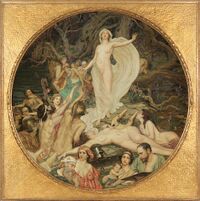
The foreign collections of paintings were arranged so that the visitor could study them in relation to the national art of and character of the American people, including the results of European influence and culture. Though American artwork had always held a back seat to European, the collection of works from the Fair's home country was deemed very high indeed.
The exhibit of paintings in the United States Section demonstrated the fact made plain at the Paris Exposition, and cordially acknowledged there, that we have a distinctive national art and like American literature, is eclectic. This exhibition was most comprehensive, including American artists living abroad, as well as an equal representation from the different sections of this country.
The New York state exhibit contained almost every New York painter of individuality and ability--in oil, water-color and miniature work, including the masterpiece works of Frederick Church.
The famous Tiffany & Company was on display at the Fair. The works of Louis Comfort Tiffany included a sterling silver Renaissance-inspired vegetable dish, a dragonfly brooch, a brooch of leaves and berries, and an ivory tusk inkstand which bears the "fleur-de-lis" mark, significance to the Art Nouveau movement.

St. Louis' artist were also proudly showcased, Noted St. Louis painter- Edmund Wuerpel displayed four paintings, and Frederick O. Sylvester exhibited his known oil The Bridge. A small bust of a baby, by Bessie Potter Vonnoh, was the only female artist from St. Louis to exhibit in the Palace of Fine Arts.
One of the highlight's was Whistler's Rosa Corder.
Foreign Collections[edit | edit source]
Europe[edit | edit source]
Austria[edit | edit source]
Art in Austria was organized in four great national societies. Besides the exhibits of the two Austrian societies, including such artists as Hugo Charlemont, Alois Schram and Karl Pippich, there were those of the Bohemian and Polish artists, each displayed distinctive national traits. Owing to the lack of space which it was possible to assign to Austria, only a portion of these collections was placed in the Art Palace, the remainder being installed in their National Pavilion.
Belgium[edit | edit source]

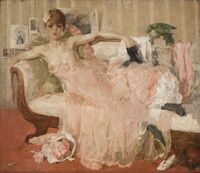
The exhibit in the Belgian Section represented the art activity of the last decade, all the paintings having been produced during that time. In the sculpture, which is installed both in the Art Palace, and the galleries of the Sculpture Pavilion. Frans Courtens, Leempoels, Heymans, Verhaert, and Gilsoul are among the noted names in Belgian art, and were represented here by important works in figure and landscape.
The paintings in the Bulgarian Section were characterized by strong and sympathetic interpretation of the national life. Among the noted artists here represented were A. Mitoff and J. V. Mrkvitchka; with a sculpture exhibit comprising statues, busts, and bronze medallions.
France[edit | edit source]

The French nation was the largest and most important one that was ever sent out of its own country. Among works in the French Section representing the older masters of that school were those of Carolus Duran, Bouguereau, Henner, Detaille, Flameng, Puvis de Chavannes, Robert Fleury, and L'hermitte. Another highlight was the first of the 21 casts authorized by Rodin of one of the most known sculptures in the world-The Thinker. The Metropolitan Museum of Art in New York, also loaned a plaster cast of François-Auguste-René Rodin's masterpiece for the Fair.
Germany[edit | edit source]
The German Section was a larger and more comprehensive exhibit than any previous exposition in this country. Lenbach, lately deceased, Germany's most famous portrait painter, was represented by five notable portraits. Adolf von Menzel, Paul Meyerheim, the historical painter von Werner, Franz von Defregger, Ludwig Knaus. Leibl, Loefftz, Schuster-Waldau, Keller, Langhammer, with many others, made this collection representative of modern German art. Noted historical paintings were lent from the public galleries of Germany. The sculptors Reinhold Begas, Peter Breuer, A. Bruett, Heinrich Epler, Ernst Freese, E. Hundrieser, Erich Hoesel and many others contributed to a large sculptural exhibit, which included many figures of heroic size.
Great Britain[edit | edit source]
The exhibition of the British Section was representative of the art work of Great Britain, Scotland and Ireland during the last decade. The Art Committee, made up of the presidents of the various art societies of the United Kingdom, gives assurance that the exhibition is national in its scope, including the three great painters, Millais, Leighton and Burne-Jones, who have died during the last decade—with others of world-wide reputation, are represented here. In sculpture, an exhibit that showed the influence of such artists as William Morris and Walter Crane—the largest exhibition of its kind which England has made at any exposition. The British exhibit, occupied fourteen rooms, showcased a theme familiar with the Fair's outlook, hence they had a sizeable exhibit of Pre-Raphelite and Neo-Classical painters oils as: Sir J. E. Millais' Chill October,Lord Federick Leighton's Persus and Pegasus with the Head of Medusa, and Sir Edward Burne-Jones' The Dream of Lancelot at the Chapel of the San Grael,were extremely well-received.
Holland[edit | edit source]
The Holland collection was mainly made up of oil paintings, water colors, etchings and engravings, with an ample sculptural presence Prominent on the walls were the works of Israels, Jacob and Willem Maris, Mesdag, and Blommers. In applied art was shown work in pottery, wood, silver, and copper. In the east pavilion, the works of Dutch artists occupied nine rooms
Hungary[edit | edit source]
In the Hungarian Section, works of the foremost artists of their national school were shown. While the list does not include all the most noted names in Hungarian art, those who were displayed maintained the high national standard. Munkacsky was represented by typical scenes from Hungarian peasant life. L. Paal, one of Hungary's best landscape artists, and K. Lotz, portrait painter and noted fresco artist, were among the well known names. The Austro-Hungarian contingent entered so late that most of its reserved space had been given away. They planned an entry featuring the work of Gustav Klimt, but the Austrian Ministry of Education objected to singling out one artist. As a result, Austrian artists boycotted the exhibition
Italy[edit | edit source]
The Italian section was entirely made up of modern art, most of the painting and sculptures had been produced since the Chicago Exposition. The late decision of the Italian Government to participate prevented the execution of works specially for the Exposition. Among the noted names in this exhibition were G. Previati, A. Rizzi, A. Ball 'Oca Bianca and C. Laurenti.
Portugal[edit | edit source]
The exhibit of Portugal was shown in one gallery, painting and sculpture being grouped together. Among the more prominent artists of Portugal were Salgado and Columbano, represented here mainly by portraits, and Jose de Brito.
Sweden[edit | edit source]
The impression made by the Swedish pictures showcased the patriotism of Sweden. Among the artists in the exhibition best known in this country were Zorn, Liljefors, and Carl Larsson.
Asia[edit | edit source]
Japan[edit | edit source]
Japan displayed cloisonné, art lacquer, enamels, sculpture and paintings. There were noted examples of the old school of landscape art, the traditions of which are the glory of Japan. The foremost bronze casters of the country are here represented by masterpieces. The sculptural exhibit included worked carved in ivory, wood, and terra cotta, and showed groups and figures illustrative of scenes in Japanese life. There were also oil paintings done by younger artists in the European method. The leaders in the school of landscape art which was so pronounced a feature of this exhibition were Gaho Hashimoto, Kwampo Araki, Keinen Imao, and Giokusho Kawabata.
Russia[edit | edit source]
Russia was represented by a collection of over six hundred works of art, consisting mainly of paintings. Ten different art societies were represented, and included paintings of such well-known members of the Imperial Academy of Arts as: Repin, Vladimir and Alexander Makofsky, Dubofsky, Kasatkine, Volkoff, Soukherofsky, Kosheleff, Venig, Verestchagin, Maimon, and von Liebhardt. In addition, there was independent collections illustrative of Ancient Russia, The Ural and its Riches and Siberia, which at that time had never before been displayed outside of Russia.
America[edit | edit source]
Argentina[edit | edit source]

The works of art exhibited in the Argentine Section were by painters and sculptors who have studied in France and Italy. They impressed fairgoers one with its individuality, sense of harmony and purity of style. Among the artists whose works were represented: Eduardo Sivori, Ernesto' de la Carcova, Eduardo Schiaffino, Pio Collivadino, Carlos Ripamonte, Cesarep de Quiros, Correa Morales, Irurtia, Dresco, Alonso, Artigue, Giudici, Garcia and Diana Dampt.
Brazil[edit | edit source]
The exhibits in the Brazilian Galleries were mostly paintings, and showcased landscapes and in figure portray the life and atmosphere of the country. Among the artists represented were Aurelio de Figueiredo, B. Calixto, P. Weingartner, M. Brocos, in etchings, and others of equal note. The art interests of Brazil were fostered by a School of Fine Arts, which offers scholarships, sending artists to European art centers for study. An interesting exhibit of applied art in this section was composed of original designs and pottery by E. Visconti.
Canada[edit | edit source]
Art in Canada was of comparatively recent growth, and the present exhibition is under the direction of the Royal Canadian Academy. The works in the Canadian galleries were entirely pictorial, and were the work of Canadian artists who studied in the art centers of Europe, and returned home to paint.
Cuba[edit | edit source]
Cuba, which for the first time exhibited as a nation at an international Exposition, showed a collection of oil paintings, engravings and lithographs. Prominent in the collection were the works of Aurelio Melero and Leopoldo Romanach.
Mexico[edit | edit source]
Mexico had an exhibit of paintings which in figure and landscape gives glimpses of the life of the country, the most notable feature of the exhibit being the collection of paintings by Antonio Fabres.
Other[edit | edit source]
The International Section were made up from the works of artists of countries not officially represented by national commissions or committees. Among them were works by Norwegian, Danish, Peruvian and Swiss artists, and an exhibit from Ceylon and China of paintings and works of applied art.
After the Fair[edit | edit source]
The main building of the Palace of Fine Arts is now the St. Louis Art Museum. Fair President David R. Francis stated "St. Louis did more (than Chicago); it set a standard of American performance in art that, while it was a surprise to foreign connoisseurs, will mark an epoch of progress of the world."
Gallery[edit | edit source]
-
Front View
-
French Exhibit
-
German Exhibit
-
German Exhibit
-
Interior
-
Interior
-
Interior
-
Interior
-
Painting
-
Painting
-
Painting
-
Painting
-
A Pearl
-
Hour of Rest by Collivandin
-
Without Bread and Without Work by Ernesto De La Carcova
-
The Intruders by Eugène Laermans
-
Venus by Henri Thomas
-
Death of the Woodcutter Léon Lhermitte
-
The Best in the Market by Richard j Bisschop
-
The Old Scribe by Jozef Israels
-
In the Harbor of Naples Gaetano Esposito
-
Gli effimeri by Andrea Tavernier
-
October by Bastert
-
Women Repairing Nets by Edgar Farazin

